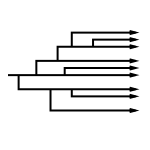Dickimaw Books Blog 
Sticky Hamburgers 🔗

The previous posts covered the migration of this website to a cloud cluster server and the site cookies (strictly necessary and optional). The optional cookie is only set if you choose to change the default site settings. This post describes those settings in more detail.
The settings page allows you to adjust various stylistic options on this site. They’re not used on every page, but if you visit the site regularly you may prefer to make some adjustments to better suit your device and taste.

The main part of this site has a yellow and green theme to match the logo’s yellow parrot holding a green book. The main banner shows the site name “Dickimaw Books” with the logo on the right. At the bottom of the banner is the cookie notice and some icon links to the RSS feed and social sites. Both the cookie notice and those icon links can be hidden by changing the default settings. (This won’t usually make a noticeable difference to the overall banner height.) If you hide the cookie notice for the main site it will also hide the cookie notice on this blog.
Below the banner is the main navigation bar (with a green background and yellow text) and below that is the area where the latest news item is displayed.
If the browser window is wide enough (over 600px) there’s a side panel on the right with additional links related to the current page. This right-hand panel will stay in view as you scroll down the page. However, if the browser window is narrow (≤600px), the panel will be moved to the area below the latest news item and will scroll off the screen (along with the banner, main navigation bar and latest news) as you move down the page. This secondary context-sensitive navigation area now starts with a “Skip to main content” link, which will take you to the start of the main page content (below the navigation area) to make it easier to skip past a potentially long navigation list.
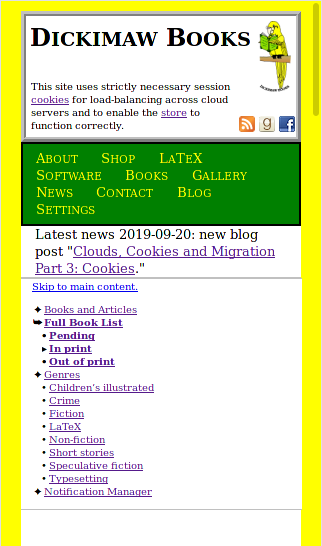
If you have a wide screen but require a large font then you may prefer to have the context navigation panel below the recent news (as with a narrow screen) instead of on the side of the page. In which case, if you go to the settings page and scroll down to the “page style” area then you can switch from the default style to the “without side panel” style (shown below).
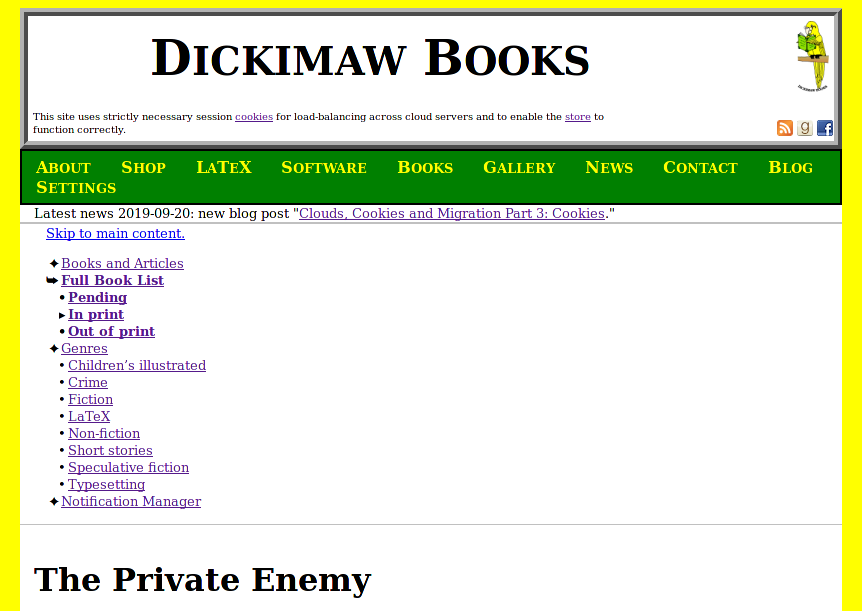
Alternatively, you may prefer to hide the context sensitive panel until you need to use it. This requires a button that can show or hide the side panel. This type of button is sometimes called a “hamburger” button because it often has an icon with three horizontal bars (representing the items in the navigation list or menu) that look a little like a stylised hamburger. Buttons that require action but don’t submit information to the webserver require client-side code to perform the action. This means that if you want to use the hamburger page style you need to allow JavaScript. Most browsers support JavaScript but some people prefer to disable it out of security concerns. So if you have disabled JavaScript, don’t use the hamburger page style.
The hamburger style also makes the main navigation bar sticky (it sticks to the top of the window). The hamburger button is placed at the right hand side of this bar so you can still access it as you scroll down the page (see image below).

Perhaps you don’t like the yellow and green, in which case there are plain versions for all of the above, which just have a grey border. For example, the plain style with side panel is shown below. (This setting will also change the colour scheme used by this blog.)
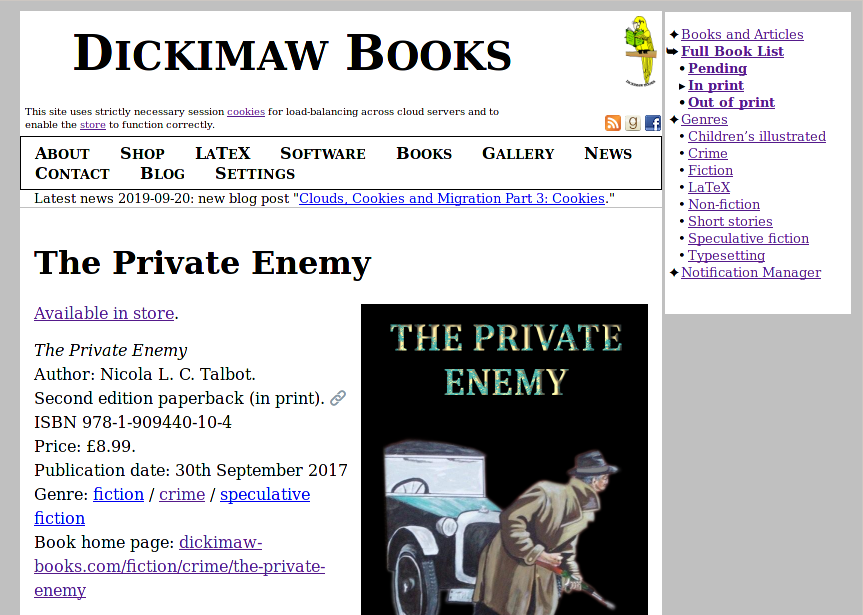
Some of the images are quite large, especially in the shop, gallery and book list. If you have a narrow screen or limited bandwidth you may prefer smaller images. In which case you can select the small images option in the settings page. Below shows the standard size image in a narrow screen compared with the same page using the small image setting.

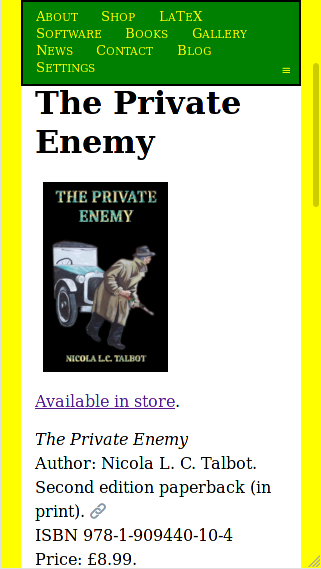
If you like to have little icons, there are a selection you can choose from. Some of the icons are images, designed for either the yellow/green or the plain styles. For example, below shows the yellow/green sticky hamburger style with image icons in the main navigation bar (following each associated text link) as well as for the bullet points in the context sensitive navigation list (not currently supported on all pages). Note also that in the main body of the page the “available in store” link is now followed by the chosen shop icon and the permalink icon has also been changed to an image icon. The side panel also has an icon to hide it (or you can click on the hamburger button again).

Most of the available icons that you can select are actually Unicode characters. Their appearance (and whether or not they are supported) depends on the font used by your browser. For example, below shows the page using coloured Unicode pictographs as the icons (in the main navigation bar and the permalink).

The same page with the same settings in a different browser with a different font is shown below. In this case the font doesn’t have coloured pictographs but instead has symbols that just use the current text font.

Not all fonts support all the possible symbols. Unavailable symbols are usually depicted with an empty rectangle or a boxed question mark.
For a more compact layout you may prefer to hide the text in the navigation bar. The image below shows the plain sticky hamburger style with no navigation text so the navigation only consists of pictographs. (It also has the small image setting on.)

The pictographs mostly relate to the topic (such as the email symbol U+1F4E7 📧 for the link to the contact page) but for those of a more fun-loving nature there are also more frivolous symbols available.
For example, the image below has the “About” icon set to the U+1F99C🦜 parrot character, the “Shop” icon set to the U+1F986 🦆 duck character, the “LaTeX” icon set to the U+1F981 🦁 lion face character, the “Software” icon set to the U+1F427 🐧 penguin character, the “Books” icon set to the U+1F989 🦉 owl character, the “Gallery” icon set to the U+1F99A 🦚 peacock character, the “News” icon set to the U+1F993 🦓 zebra face character, the “Contact” icon set to the U+1F40C 🐌 snail character, the “Blog” icon set to the U+1F99B 🦛 hippopotamus character, the “Settings” icon set to the U+1F984 🦄 unicorn face character, and the menu icon set to the U+1F995 🦕 sauropod character. The close icon for the side panel is the U+1F996 🦖 t-rex character. The page also has the U+1F418 🐘 elephant character for the permalink and the context-sensitive navigation list has the U+1F95A 🥚 egg and U+1F423 🐣 hatching chick characters for the top-level, and the U+1F41B 🐛 bug and U+1F98B 🦋 butterfly characters for the second level.

The settings are stored in a cookie. You can opt for a session cookie, which your browser should delete at the end of the session (but remember from the previous post that some browsers use session restoring) or you can opt for a persistent cookie. Once the cookie expires or if you use your browser privacy settings to delete it, the site will revert back to its default style.
[Update 2023-05-05: this blog now uses the same page style as the main part of the site.]
Next Post
 There are some interesting little curiosities in our village and the surrounding area, such as the Foxhole bus stop at the end of Long Lane that has “No bus services currently operate in this area” displayed on it."
There are some interesting little curiosities in our village and the surrounding area, such as the Foxhole bus stop at the end of Long Lane that has “No bus services currently operate in this area” displayed on it."Previous Post
Recent Posts
 There are a growing number of digital historians who are interested in documenting old computing systems from the twentieth century, but much of the information has been lost and coincident names can make it hard to search. This article is about the RISC OS ARMTeX distribution, which provided TeX and LaTeX for the ARM-powered Acorn computers in the 1990s.
There are a growing number of digital historians who are interested in documenting old computing systems from the twentieth century, but much of the information has been lost and coincident names can make it hard to search. This article is about the RISC OS ARMTeX distribution, which provided TeX and LaTeX for the ARM-powered Acorn computers in the 1990s.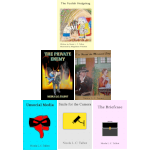 The DRM-free ebook retailer SmashWords has its annual Summer/Winter sale from 1st – 31st July 2025. My crime novel “The Private Enemy” and children’s illustrated story “The Foolish Hedgehog” both have a 50% discount, and my crime fiction short stories “I’ve Heard the Mermaid Sing”, “Unsocial Media”, “Smile for the Camera”, and “The Briefcase” have a 100% discount (i.e. free!) for the duration of the sale. Did you know that you can gift ebooks on SmashWords?
The DRM-free ebook retailer SmashWords has its annual Summer/Winter sale from 1st – 31st July 2025. My crime novel “The Private Enemy” and children’s illustrated story “The Foolish Hedgehog” both have a 50% discount, and my crime fiction short stories “I’ve Heard the Mermaid Sing”, “Unsocial Media”, “Smile for the Camera”, and “The Briefcase” have a 100% discount (i.e. free!) for the duration of the sale. Did you know that you can gift ebooks on SmashWords?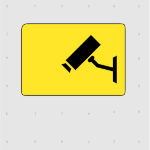 If you have read my short story Smile for the Camera, did you notice that the ending could have two possible interpretations? (No spoilers please!) As a writer, it’s always difficult to tell if something is too obvious or too obscure. If you need a hint, consider the naming scheme and remember that not everyone is what they say or imply that they are.
If you have read my short story Smile for the Camera, did you notice that the ending could have two possible interpretations? (No spoilers please!) As a writer, it’s always difficult to tell if something is too obvious or too obscure. If you need a hint, consider the naming scheme and remember that not everyone is what they say or imply that they are. The Ex-Cathedra writing group were delighted to present a cheque for £1,400 to St Martins Housing Trust during their collection at Tesco Harford Bridge on 6th December 2024. The money was raised from sales of the book Tales for Our Times, an anthology of short stories written by the group. The cheque was received by Ian Hanwell on behalf of St Martins. Many thanks to the support of everyone who purchased a copy and to the staff at Tesco Harford Bridge for allowing us to make the presentation there.
The Ex-Cathedra writing group were delighted to present a cheque for £1,400 to St Martins Housing Trust during their collection at Tesco Harford Bridge on 6th December 2024. The money was raised from sales of the book Tales for Our Times, an anthology of short stories written by the group. The cheque was received by Ian Hanwell on behalf of St Martins. Many thanks to the support of everyone who purchased a copy and to the staff at Tesco Harford Bridge for allowing us to make the presentation there. Search Blog
📂 Categories
- Autism
- Books
- Children’s Illustrated Fiction
- Illustrated fiction for young children: The Foolish Hedgehog and Quack, Quack, Quack. Give My Hat Back!
- Creative Writing
- The art of writing fiction, inspiration and themes.
- Crime Fiction
- The crime fiction category covers the crime novels The Private Enemy and The Fourth Protectorate and also the crime short stories I’ve Heard the Mermaid Sing and I’ve Heard the Mermaid Sing.
- Fiction
- Fiction books and other stories.
- Language
- Natural languages including regional dialects.
- (La)TeX
- The TeX typesetting system in general or the LaTeX format in particular.
- Music
- Norfolk
- This category is about the county of Norfolk in East Anglia (the eastern bulgy bit of England). It’s where The Private Enemy is set and is also where the author lives.
- RISC OS
- An operating system created by Acorn Computers in the late 1980s and 1990s.
- Security
- Site
- Information about the Dickimaw Books site.
- Software
- Open source software written by Nicola Talbot, which usually has some connection to (La)TeX.
- Speculative Fiction
- The speculative fiction category includes the novel The Private Enemy (set in the future), the alternative history novel The Fourth Protectorate, and the fantasy novel Muirgealia.
🔖 Tags
- Account
- Alternative History
- Sub-genre of speculative fiction, alternative history is “what if?” fiction.
- book samples
- Bots
- Conservation of Detail
- A part of the creative writing process, conservation of detail essentially means that only significant information should be added to a work of fiction.
- Cookies
- Information about the site cookies.
- Dialect
- Regional dialects, in particular the Norfolk dialect.
- Docker
- Education
- The education system.
- Ex-Cathedra
- A Norfolk-based writing group.
- Fantasy
- Sub-genre of speculative fiction involving magical elements.
- File formats
- Hippochette
- A pochette (pocket violin) with a hippo headpiece.
- History
- I’ve Heard the Mermaid Sing
- A crime fiction short story (available as an ebook) set in the late 1920s on the RMS Aquitania. See the story’s main page for further details.
- Inspirations
- The little things that inspired the author’s stories.
- Linux
- Migration
- Posts about the website migration.
- Muirgealia
- A fantasy novel. See the book’s main page for further details.
- News
- Notifications
- Online Store
- Posts about the Dickimaw Books store.
- Quack, Quack, Quack. Give My Hat Back!
- Information about the illustrated children’s book. See the book’s main page for further details.
- Re-published
- Articles that were previously published elsewhere and reproduced on this blog in order to collect them all together in one place.
- Sale
- Posts about sales that are running or are pending at the time of the post.
- Site settings
- Information about the site settings.
- Smile for the Camera
- A cybercrime short story about CCTV operator monitoring a store’s self-service tills who sees too much information.
- Story creation
- The process of creating stories.
- TeX Live
- The Briefcase
- A crime fiction short story (available as an ebook). See the story’s main page for further details.
- The Foolish Hedgehog
- Information about the illustrated children’s book. See the book’s main page for further details.
- The Fourth Protectorate
- Alternative history novel set in 1980s/90s London. See the book’s main page for further details.
- The Private Enemy
- A crime/speculative fiction novel set in a future Norfolk run by gangsters. See the book’s main page for further details.
- Unsocial Media
- A cybercrime fiction short story (available as an ebook). See the story’s main page for further details.
- World Book Day
- World Book Day (UK and Ireland) is an annual charity event held in the United Kingdom and the Republic of Ireland on the first Thursday in March. It’s a local version of the global UNESCO World Book Day.
- World Homeless Day
- World Homeless Day is marked every year on 10 October to draw attention to the needs of people experiencing homelessness.


